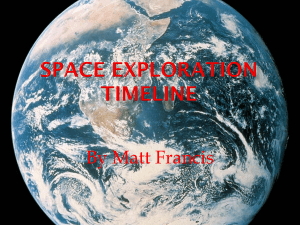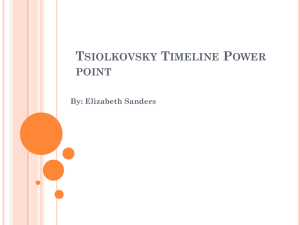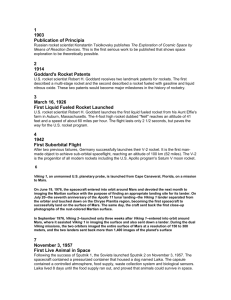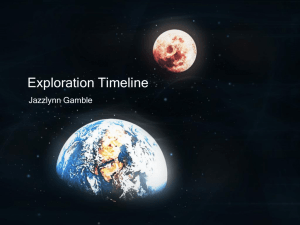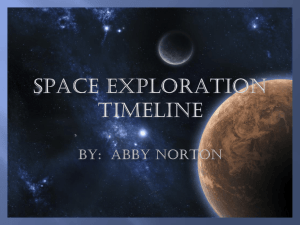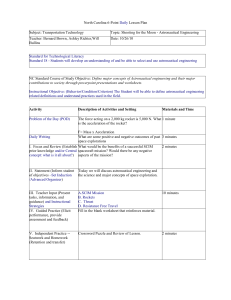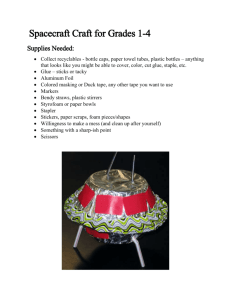Space Exploration Timeline
advertisement
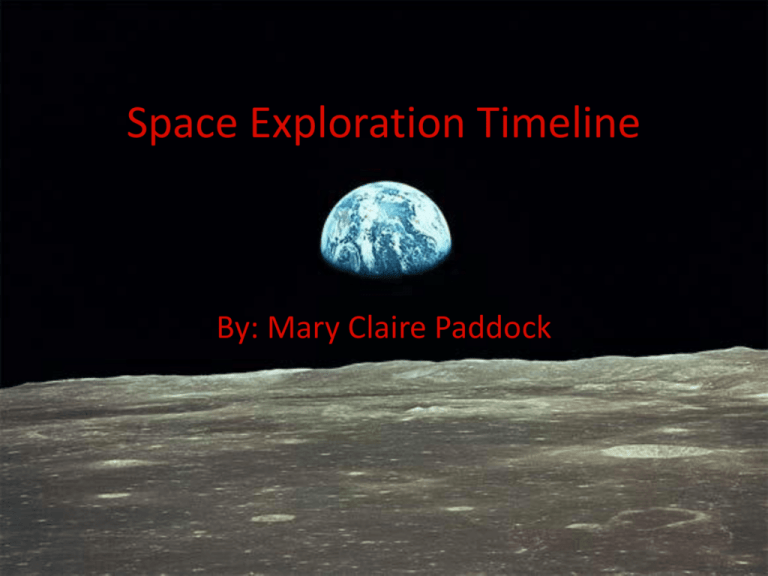
Space Exploration Timeline By: Mary Claire Paddock 1900 • Konstantin Tsiolkovsky(1857-1935) was a self educated Russian scientist known as the father of cosmonautics and rocket dynamics. In 1926 he defined 16 steps for human expansion into space as part of his “Plan of Space Exploration.” 1914 • In 1914 American scientist, Robert H. Goddard, had his first two patents accepted and registered. The first described a multistage rocket. The second described a rocket fueled with nitrous oxide. These two patents would become important milestones in the history of rocketry. 1926 • American professor, physicist, and inventor, Robert H. Goddard, is credited with creating and building the world’s first liquid-fueled rocked on March 16, 1926. During his life, Goddard obtained 214 patents relating to rocket design. 1930 • Wernher von Braun (1912 – 1977), a GermanAmerican rocket scientist was responsible for the design and realization of the deadly V-2 combat rocket for the Nazi’s during World War II. After the war, he and his team were “scooped up” and send to America. He later became a director of NASA. 1944 On September 4, 1944, the V2 spacecraft leaves the Earth’s atmosphere during World War II. The German’s fired the V2 against Paris, but it mistakenly hit London. 1954 On May 24, 1954, Americans launched Viking 11 for a suborbital flight from White Sands Missile Range in southern New Mexico. Viking 11 rose to 158 miles, an altitude record for a western single-stage rocket. 1957 On October 4, 1957, the Soviet Union launched the first earth orbiting satellite. The launch ushered in new political, military, technological, and scientific developments and marked the start of the Space Age. 1961 On April 12, 1961, Russian cosmonaut, Yuri Gagarin, became the first human in space, making a 108 minute orbital flight in his Vostok 1 spacecraft. 1961 • Mercury Redstone 3, a U.S. manned space mission, launched on May 5,1961, from Cape Canavarel, Florida. The Mercury space craft was named Freedom 7 and was manned by astronaut Alan Shepard who beacme the first American in space. The flight was less than 16 minutes and attained an altitude of just over 116 miles. 1967 Lunar Orbitor missions were operated by the U.S. from 1961-1967. The Lunar Orbitor programs consisted of five unmanned spacecraft which returned photography of 99% of the moon. 1969 • On July 21,1969, American aviator, Neil Armstrong, became the first person to set foot on the moon. When he made that step he spoke the now famous words, “That’s one small step for man, one giant leap for mankind.” 1971 • On April 19, 1971, Soviets launched Salyut 1, the first space station put into orbit. It completed 362 orbits before before deorbiting and reentering the atmosphere over the Pacific Ocean in October. It was destroyed by frictional heating during its return. 1971 • Mariner 9 was launched by the U. S. on May 30, 1971. On November 13, it reached Mars and became the first artificial satellite to orbit Mars. The spacecraft took 7,329 photos of the moon and stayed in orbit for 349 days. 1972 Apollo 16 was the 10th manned mission in the United State’s Apollo program. The mission was launched on April 16, 1972, and concluded on April 27. In route to the moon, Apollo 16 astronauts took several photos of the Earth. 1973 • On May 14, 1973, the U. S. landed its first space station, Skylab, in order to establish a permanent foothold in space. Additionally, Skylab performed many scientific studies. In 1979 Skylab fell out of orbit and into the Indian Ocean because of increased solar activity. 1976 • On July 20, 1976, the Viking I Lander separated from the Orbitor and began its descent to the surface of Mars. This was the first U.S. space probe to land on another planet. Viking I released Martian images and conducted experiments studying the atmospheric and soil composition of Mars. 1979 On March 28, 1979, Skylab, the first U.S. Space Station, presents the first satellite observations of the outer cornea of the sun. Soft x-ray images of the sun were taken with a S-054 x-ray telescope on Skylab. 1981 • On April 12, 1981, the first U.S. reusable space shuttle, Columbia, roared into the sky from Kennedy Space Center. Of its three components, the orbiter space plane, rocket boosters, and external fuel tank, only the fuel tank is not recovered after a mission. 1983 • On April 24, 1983, the United States Space Shuttle Challenger takes photographs of the Earth showing the continent of Australia. 1986 • On February 20, 1986, (three weeks after the Challenger disaster) the Soviets launch the world’s largest Space Station, Mir. Mir, which means both peace and world in Russian, is intended to provide a base for a permanently manned complex orbiting Earth. 1990 On April 24, 1990, the Hubble Space Telescope was carried into orbit by the U. S. Space Shuttle Discovery. Although not the first space telescope, it was one of the largest and most versatile. The telescope was named after astronomer, Edwin Hubble. This is the only telescope designed to be serviced in space by astronauts. 1995 • The Galileo spacecraft was designed by the United States to study Jupiter’s atmosphere, satellites, and surrounding magnetosphere for two years. Galileo was launched on October 18, 1995, and entered Jupiter’s atmosphere on December 7, 1995. Galileo sent back valuable photos and data relating to Jupiter’s composition. 1996 • On December 4, 1996, the Mars Pathfinder, an American spacecraft, was launched in order to deploy the first roving probe on another planet. Rover rolled onto Mars’ surface on July 6. This mission had the primary objective of demonstrating the feasibility of low-cost landings on and the exploration of the Martian surface. 1998 • On November 20, 1998, the first module of the International Space Station (ISS), Zyra, was launched by Russia on a proton rocket. Two weeks later, the U. S. launched Unity, the first of three modules aboard Space Shuttle flight STS-88. Primarily a research laboratory, the ISS offered an advantage over spacecraft because of its long-term platform in the space environment, where extended studies would be performed.
